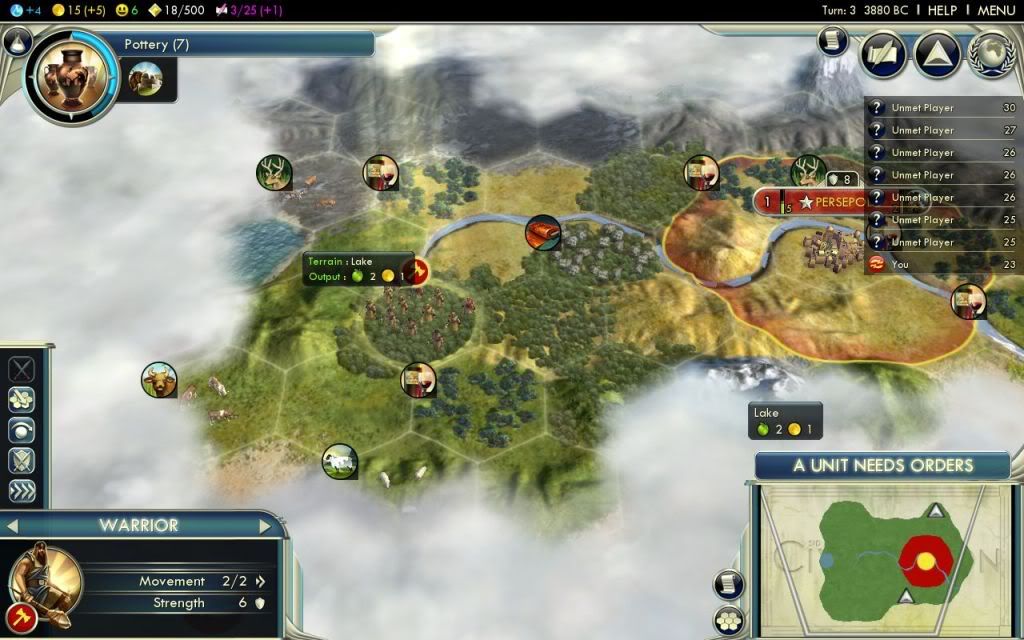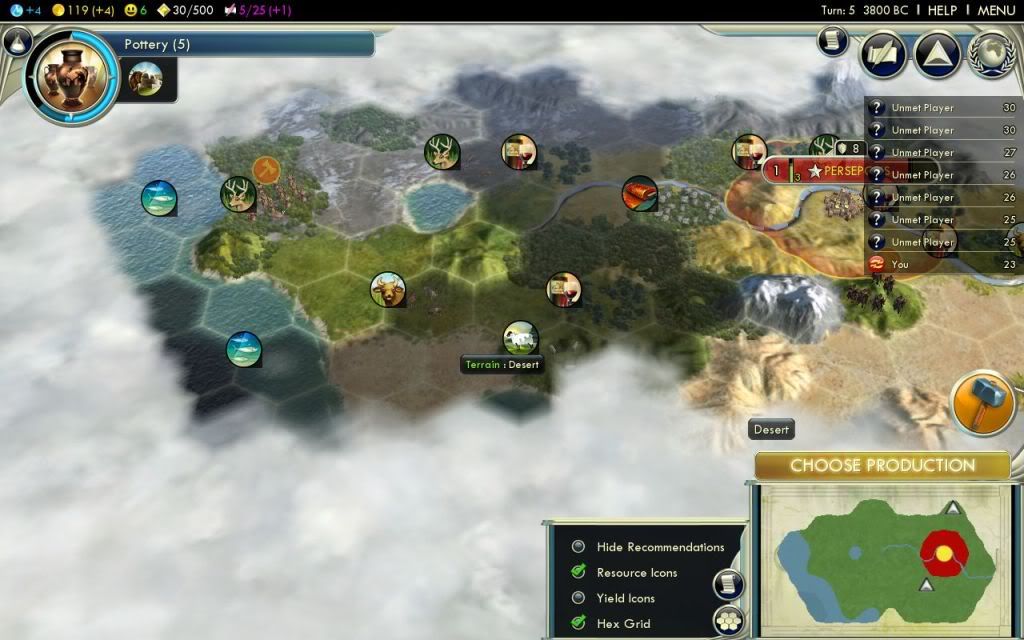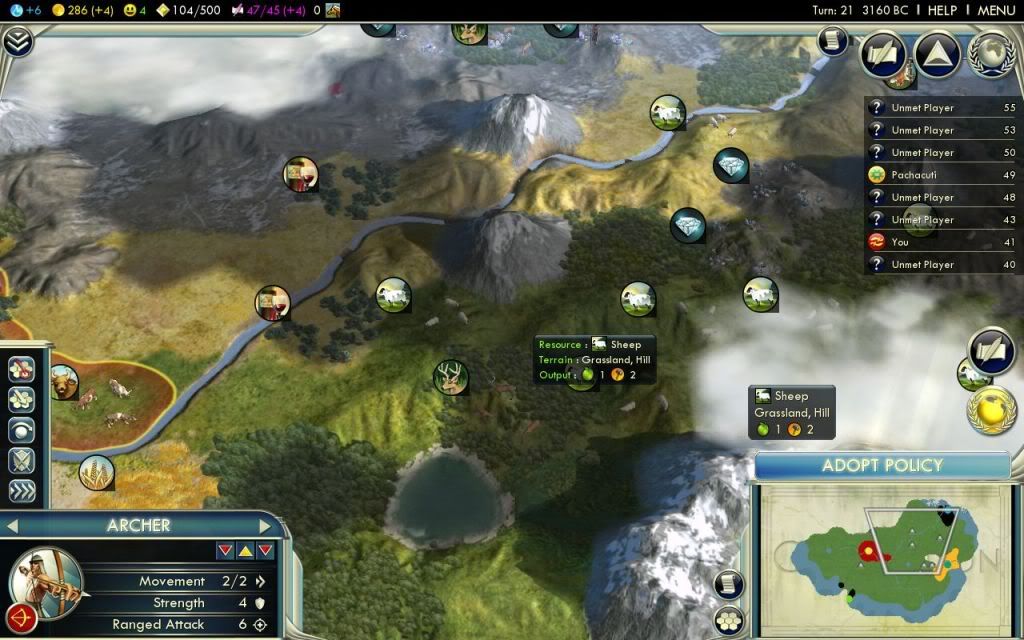Welcome back, my son. I've missed you. Have the men begun setting up the encampment?
Yes, father.
Good. This is lush, fertile land. I think we can make a home here.
I agree. There's enough wine here to keep you snockered for the rest of your decrepit life. Now do I have to hear about that dream of yours again?
~ ~ ~
Surprising no one, least of all Darius' dutiful son, we settled in place, and the old guy got to boozing.
Inside Perseopolis, we started building a scout and worked the riverside deer tile for a decent 2F/1H/1C. Meanwhile, our starting warrior headed west in search of ancient ruins and some decent haleem.
He found no haleem, nor indeed any other of his favorite dishes, but he did stumble upon a great city location, chock full of grapes. There was much rejoicing. Monasteries, anyone?
A nearby ruin yielded a rich return of gold. What civilization had thrived and died, leaving such a trove in the wilderness?
~ Strategic Interlude ~
By the start of turn 6, our scout had completed and it was clear that we had good land to expand westward, though I had not yet found any new unique resources with which to support a REX strategy. My only viable build options at this point were:
1. second scout
2. worker
3. monument
4. warrior
My sense of the map was that I was going to be using both the Tradition AND Liberty trees. With all the nearby wine, I could make a reasonable go at a small (2-4 city) culture win as well as the other victory conditions. Other questions remained:
How to best generate GA-triggering events on this map?
a.
wonders -- possible, but no marble. would need maritime city-states to supply food for Perseopolis to be a hammer capital; consider taking Aristocracy in Tradition for wonder boost?
b.
great people -- the two western city locations would both support high-food, great people-focused cities.
c.
policies -- Liberty and Piety each contain GA-granting policies.
d.
happiness -- there is not a lot of it visible at the moment.
Funny how a simple second build decision seems to impact the whole opening strategy, based on just five turns of play ...
Here's the western frontier:
On the coast is a decent great person farm that could run several specialists (especially with landed elite and a granary) from the two fish and one deer tile. Along the western river is the aforementioned wine site, great for culture and commerce.
At this point, only barely explored the east, but it appears to be floodplain heaven, suggesting lots of food and commerce for specialists.
Early indications are that my Golden Ages are going to come from great people, wonders built in Perseopolis, and policies from monastery-fueled culture and cutural city states bribed with my nice commerce tiles. It's going to be a challenge to generate a golden age solely with my luxury-based happiness if I expand very much.
Based on this very early assessment, I am going to assume that I can't REX hard right away, due to the lack of new happy resources. I am going to be limited to one or two new cities until I can find more happiness. So ... I'm going to commit to Tradition, skip the monument, and build a scout. I wavered as to building a warrior instead, as the starting land appears to be fairly flat, and a warrior is a more durable scouting unit that could double as a garrison unit later. Ultimately, though, I have found that building a second scout often comes in handy and keeps me from engaing in fruitless barbarian battles that I would otherwise fight if I had a warrior. So a second scout is the build. This also works out nicely timing-wise, as it will finish on the same turn as Pottery, giving me the option to build a granary right away.
I am skipping a worker at the moment because he would arrive with nothing to do other than farm a riverside plain, which is the same production as my unimproved riverside deer tile. So a second scout it is. I will tech AH>Trapping>Calendar after Pottery finishes.
~ Gameplay Resumed ~
Belgrade was met to the southwest; Military, Friendly, and in possession of a gold tile.
Pottery came in, and as planned I took Animal Lovin' next.
Our scout found ruins describing use of a strange wood and twine contraption that fired "arrows." They shrugged and trundled off, unaware of their new ranged firepower.
With the second scout completed, it was clear that a worker was still premature, as I had no worthwhile tiles to improve. I started on a granary and moved Perseopolis to a production posture, stagnating growth but delivering the Granary two turns earlier than otherwise.
On Turn 12, we met the Inca, who presumably are from further east.
There are a TON of wine tiles on this map. I've counted 8 so far ... 3 at Perseopolis, 2 to the west, 2 to the east, and 1 to the southeast. Drunk Immortals comin' atcha!
Snagged a ruin right from under Pacabooty's nose. Love that. More population for Perseoplis.
Turn 12 was also the first time I found a new unique luxury, a gem tile pretty far to the southeast. And a ton more of them were found to the east the next turn by scout 2. Hmm. The more I explore, the more this smells like a small continent, shared with the Inca. My sense is that lopsided resources tend to indicate relative isolation.
And then, on turn 14, the holy of holies ... the culture ruin. Oh yes. Another reason I love building two scouts. I also found marble to the southeast, near the gem tile I first found. For those of you keeping score at home, that's a whopping (...) two unique happy resources so far, plus one from a friendly city-state, after a lot of scouting.
With the culture ruin, I go ahead and take Tradition based on my earlier assessment. Would that come back to bite me?
Venice met ... Maritime, Irrational, Furs. Another new luxury, and maritime, so not too shabby all in all.
I spent a few turns searching for the Inca to the east but was having no luck finding their hilly, slinger-infested homelands. When I finally found them, they were tucked behind a short mountain range. Good land, with gems and gold and the ubiquitous highland terrain, but in a position where they could be blocked ...
The map is so great, so much land to expand into, but there is just not enough happiness to sustain a REX in the early game.
The granary finished, and I was working on Trapping, having already completed Animal Husbandry. It was time for a worker, who when built could pasture the cows now in Perseopolis' workable area plus the deer. I stayed in a production focus with my citizens, saving a whopping six turns on construction time from the default production scheme.
Regarding the Inca: I have my scout-promoted to Archer parked on a hill, ready to worker steal if possible. He is also guarding a nice marble/gems happiness site for my possible expansion. The Inca could be at least partially bottled up from the rest of the continent if I put a city down there quickly.
Turn 21, my second policy came in, and I stopped the round here for reflection and comment from the peanut gallery. Why? Questions and comments, of course!
Here is the scouted land to Perseopolis' east:
And to the southeast, including the marble/gem site:
~ ~ ~
Discussion Topics:
1. What do you make of my reasoning and gameplay overall? I'm a decent King player but no expert, and am open to suggestions. Also, I don't particularly care what victory condition I pursue.
2. Strategic Options:
2a.
Monastery/Legalism: In theory, with all of my ridiculous available wine tiles, I could use Legalism to get four instant monasteries and about +28 culture, if I am willing to wait to get Theology before taking Legalism and build three more cities and monuments in all of them first. Do I have this right? Or will I get temples instead, since I have to take Philosophy to research Theology? If I'm right, wouldn't a few Liberty policies and a quick REX to four cities get me to Theology? If this is possible, it would seem to benefit a multi-city cultural strategy and offset the multiple city penalty inherent in getting new social policies. There are many downsides to this, not the least of which that none of the wine cities offers new happiness resources; I would have to use policies (Monarchy and Piety come to mind) and happiness buildings to manufacture the needed offsetting happiness.
2b.
Straight Tradition: Sticking with the original gameplan conceived on turn 6, taking Legalism now and Landed Elite right away, while building a few cities to claim happy resources (hopefully the gems/marble site) and partially block the Inca. I consider this a safe choice, and it also gives me access to Monarchy later for some extra happiness and gpt. This strategy also keeps the window for an OCC game open. It does, however, put Meritocracy way, way back.
2c.
Tradition/Liberty REX: Taking Liberty and Collective rule right away, trying to fully block the Inca with two quick settlers. The biggest downside to this is the opportunity cost of delaying both Landed Elite and Meritocracy, plus the fact that the map will not support more than four cities with just four workable happiness resources. A REX would essentially commit my cash to City-State alliances and my hammers to happiness buildings while pretty much eliminating the thought of a culture win. I am guessing this strategy would lead to either a hunker-down science win or GA-fueled production-explosion world-conquering extravaganza.
2d.
Tradition/Liberty Meritocracy: Going straight there, Liberty > Citizenship > Meritocracy, with the idea of either using a research agreement with the Inca or hard-researching to get Civil Service and then rush-buidling Chichen Itza with a Great Engineer. This would require me beelining Philosophy right after getting Calendar.
2e.
Rush the Inca. While I would be without Research Agreements until Astronomy, this rather appealing option (against a known wonder-builder) would give me the continent all to myself and in great position for a science or culture win. A quick beeline to Iron Working and a research agreement with the Inca to get Steel and put Cuzco to the sword?
2f. Any other strategic options from you?
3. How does all of this fit into my plan for a superlong golden age?
4. I have noted in the past that the Inca tend not to expand early. So perhaps going bananas trying to block them is unncessary early.

 for growth and big
for growth and big  when the important builds become available. If there are enough Maritimes, you won't need to farm the riverside Hills.
when the important builds become available. If there are enough Maritimes, you won't need to farm the riverside Hills. GA at bay via expansion and growth until you're ready to set off the bomb.
GA at bay via expansion and growth until you're ready to set off the bomb.




